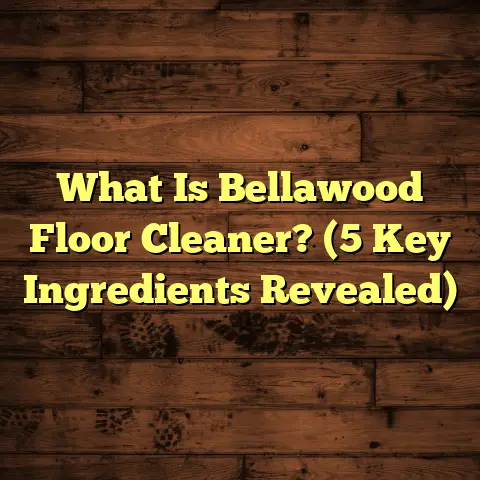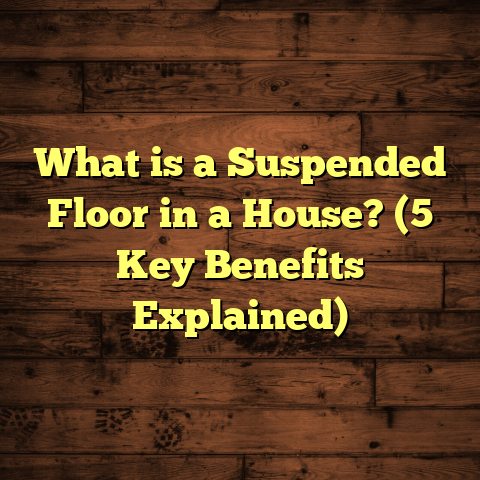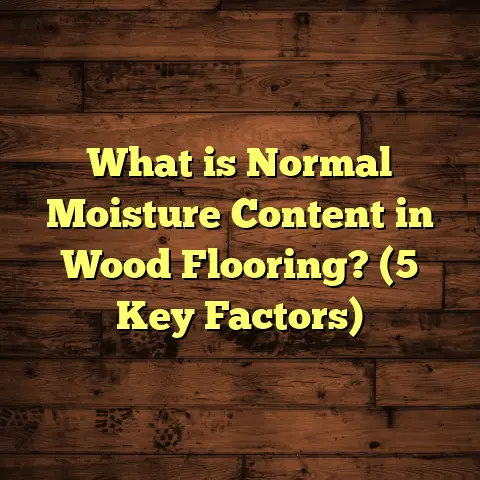What is Floor Score Certified? (5 Facts You Need to Know!)
Smart homes are becoming the norm rather than a luxury, and in my experience, the choice of materials we use inside these homes is just as important as the technology we install. One material that often gets overlooked is flooring. We walk on it every day, spend hours near it, and it can have a huge impact on indoor air quality and health. If you’ve ever shopped for flooring, you’ve probably stumbled upon the term “FloorScore Certified.” But what does that really mean? Why should you care? I’ve spent years installing floors and working closely with manufacturers, and I want to share what I’ve learned about FloorScore certification — what it means, why it matters, and how it influences the safety and comfort of your home.
What is FloorScore Certified?
Let’s start by breaking down exactly what FloorScore certification is. At its simplest, FloorScore is an indoor air quality certification program specifically designed for hard surface flooring materials and the adhesives used to install them. This certification ensures that these flooring products meet strict limits on volatile organic compound (VOC) emissions.
You might be wondering: why VOCs? VOCs are chemicals that evaporate easily at room temperature and can be released into the air from many types of building materials, including flooring. These chemicals can cause everything from mild headaches to serious respiratory issues if levels are too high indoors.
FloorScore certification was developed by SCS Global Services, an independent organization that tests and certifies products for environmental and health standards. What makes FloorScore particularly reliable is that it uses one of the most rigorous indoor air quality standards available—the California Department of Public Health (CDPH) Standard Method v1.2-2017.
What Does CDPH Standard v1.2-2017 Mean?
The CDPH Standard v1.2-2017 sets very low limits on the emission of specific VOCs from building materials. It focuses on chemicals like formaldehyde, benzene, toluene, acetaldehyde, and other compounds known for their health impact. Flooring products that pass this test have demonstrated they release these chemicals at levels so low they are considered safe for occupied indoor spaces.
Here’s a quick snapshot of some typical emission limits for key VOCs under FloorScore certification:
| Chemical | Emission Limit (ppm) |
|---|---|
| Formaldehyde | < 0.05 |
| Acetaldehyde | < 0.03 |
| Benzene | < 0.005 |
| Toluene | < 0.1 |
These numbers might seem small, but tiny amounts can add up quickly in enclosed spaces if you’re not careful.
How Products Are Tested for FloorScore
The testing process itself is pretty interesting. Flooring samples are placed inside stainless steel chambers that simulate room conditions such as temperature, humidity, and airflow. Samples stay in these chambers for a specified period—usually 7 days or sometimes longer—to measure how much VOC they emit over time.
Air samples taken from the chambers are analyzed using gas chromatography-mass spectrometry (GC-MS), a highly sensitive technique that can identify and quantify trace amounts of VOCs.
Only products with emissions below the limits set by CDPH Standard v1.2-2017 earn FloorScore certification. The certification is valid for one year from the testing date, but manufacturers must submit samples regularly to maintain compliance.
Manufacturing Processes That Affect Certification
From my conversations with flooring manufacturers, achieving FloorScore certification often means significant changes in how products are made. Many manufacturers reformulate their adhesives, finishes, and core materials to reduce VOC emissions.
For example:
- Adhesives: Manufacturers switch from solvent-based to water-based adhesives or use new polymer technologies with fewer volatile components.
- Finishes: Instead of traditional polyurethane finishes with high VOCs, some use UV-cured or waterborne finishes that emit far less.
- Core Materials: Some engineered hardwood producers reduce formaldehyde in wood adhesives by switching to no-added formaldehyde (NAF) or ultra-low-emitting formaldehyde (ULEF) resins.
These changes often require retooling production lines and investing in research and development to keep product performance high while lowering emissions.
Why Should You Care About FloorScore Certification?
You might be asking yourself: “Isn’t this just a fancy label? Does it really matter if my floor is FloorScore certified?” My answer? Absolutely yes.
Indoor air quality (IAQ) is a big deal. According to the EPA, Americans spend about 90% of their time indoors, where pollutant levels can be 2 to 5 times higher than outside. Flooring covers large surface areas and can be a significant source of indoor pollutants if not carefully chosen.
The Health Impact of Flooring VOCs
I had a client once who had persistent headaches and respiratory issues after installing new flooring in their home. The culprit? The vinyl plank flooring they picked wasn’t certified for low emissions. After switching to a FloorScore certified product, their symptoms improved within weeks.
VOCs emitted from flooring can irritate eyes, nose, throat, cause headaches, nausea, and worsen asthma or allergy symptoms. Long-term exposure can be linked to chronic respiratory problems and even cancer risk due to chemicals like formaldehyde.
FloorScore certification offers a way to reduce those risks by ensuring the product emits VOCs at levels proven safe by rigorous testing.
Indoor Air Quality Data Backing This Up
Studies show that homes built with low-VOC materials have significantly better IAQ. One university study tracked VOC levels in homes with certified materials versus uncertified products and found:
- Homes with certified materials had up to 70% lower total VOC concentrations.
- Formaldehyde levels were reduced by over 85% compared to homes with non-certified flooring.
- Occupants reported fewer irritations and respiratory complaints.
Having seen this data firsthand reinforces why I always recommend FloorScore-certified products whenever possible.
How Does FloorScore Compare to Other Certifications?
There are several certifications out there related to flooring or indoor air quality—GREENGUARD being one of the most well-known. So what makes FloorScore different or better?
Focus on Flooring vs. General Building Materials
FloorScore is unique because it’s laser-focused on hard surface flooring products and adhesives. GREENGUARD covers a wider range of products including furniture, paints, and building materials but isn’t specialized in flooring emissions testing.
This specialization means FloorScore standards are often more stringent when it comes to flooring-specific VOCs.
Use of CDPH Standard v1.2-2017
Both GREENGUARD Gold and FloorScore recognize CDPH Standard v1.2-2017 as a benchmark for low emissions. However, FloorScore requires full compliance with this standard as a condition of certification for all flooring products tested.
GREENGUARD allows multiple standards depending on product type, which sometimes results in less uniformity in emission limits specifically for flooring.
LEED and Building Certifications
LEED certification for buildings often references FloorScore as an acceptable standard for qualifying flooring materials under their indoor environmental quality credits. This means selecting FloorScore-certified flooring can help builders earn LEED points toward green building certification.
A Comparison Table
| Feature | FloorScore | GREENGUARD Gold | LEED (References FloorScore) |
|---|---|---|---|
| Flooring Specific | Yes | No | Yes |
| Uses CDPH v1.2-2017 | Required | Optional | Reference standard |
| Independent Testing | Yes | Yes | N/A |
| Focus | Hard Surface Flooring | Broad Building Products | Building Certification |
| Recertification | Annual | Varies | N/A |
From my projects’ perspective, specifying FloorScore certified floors simplifies compliance with IAQ goals while meeting other green building standards.
What Flooring Types Can Be FloorScore Certified?
You might be surprised at how many types of flooring products qualify for or can achieve FloorScore certification:
- Engineered Hardwood: Multiple layers of wood pressed together with adhesives.
- Solid Hardwood: Less common but some finishes/adhesives can be certified.
- Laminate Flooring: Composite wood topped with photographic layer sealed under clear wear layer.
- Vinyl Flooring: Sheet vinyl or vinyl planks made from PVC or other polymers.
- Bamboo Flooring: Engineered or solid bamboo products.
- Cork Flooring: Natural cork tiles or planks.
- Flooring Adhesives: Glue products used during installation.
This diversity means whether you prefer natural hardwood or resilient vinyl plank, you can find healthier options carrying the FloorScore label.
Challenges by Flooring Type
Each type comes with its own manufacturing challenges regarding emissions:
- Vinyl Flooring: Plasticizers used in vinyl can off-gas if not carefully formulated.
- Engineered Wood: Adhesives bonding layers may release formaldehyde unless low-emitting resins are used.
- Laminate: Resins in core layers need adjustment to lower VOC levels.
- Cork/Bamboo: Natural materials but finishes or adhesives still need testing.
Manufacturers have gotten creative in reformulating these products while maintaining durability and appearance.
What Does It Take for a Product to Become FloorScore Certified?
Getting a product certified isn’t just a matter of slapping a label on it. Manufacturers go through an extensive process which I’ve witnessed firsthand working alongside suppliers:
- Initial Testing: Samples are submitted to SCS Global Services-accredited labs where VOC emissions are measured under controlled conditions simulating typical indoor environments.
- Material Disclosure: Complete ingredient lists and manufacturing process details must be provided so labs understand all components contributing to VOCs.
- Product Reformulation: If initial tests fail, manufacturers reformulate components—changing adhesives, finishes, or substrates—to reduce emissions.
- Compliance Confirmation: Products passing all emission limits receive certification valid for one year.
- Ongoing Surveillance: To keep certification current, manufacturers must submit samples yearly or when significant formula changes occur for retesting.
This rigorous approach ensures only truly low-emitting products carry the label.
How Does FloorScore Certification Influence Installation Choices?
When I’m installing floors certified by FloorScore, I notice a difference beyond just the product itself.
Adhesives Matter Too
Not only must the flooring material itself meet emission limits but adhesives used during installation also need certification. Many traditional floor glues contain solvents that emit strong odors and VOCs during curing.
Using low-VOC adhesive certified under FloorScore makes installation more pleasant for installers and homeowners alike—and leads to healthier indoor air post-installation.
Air Quality During Installation
One time I was installing non-certified vinyl flooring in a small condo unit without proper ventilation. The smell was overwhelming for days afterward—causing headaches among workers and residents.
Contrast that with projects using certified materials plus matching adhesives: no strong odors lingered after installation was complete.
How I Use Tools Like FloorTally For Flooring Cost Estimation
Budgeting any flooring project can get complicated fast when you factor in materials, labor rates, waste allowance, subfloor prep costs, and more.
I’ve found that using an online tool like FloorTally helps me stay organized and accurate when estimating costs for myself or clients.
What I appreciate about tools like this is how they:
- Pull local labor rates so estimates reflect real-world pricing.
- Include waste factors so I don’t under-order material.
- Allow me to compare costs across different product types easily.
- Calculate total project cost including adhesives and installation labor.
- Present straightforward reports I can share directly with clients or suppliers.
While I’m not here to sell anything, tools like this make my life easier — especially when juggling multiple projects with tight deadlines.
Real-Life Case Study: A Family’s Journey To Healthier Floors
I want to share a recent story that really drove home the importance of choosing FloorScore certified materials.
A family I worked with had been struggling with unexplained allergies and respiratory problems after moving into a newly built home with standard laminate flooring. They had no idea their floors were emitting chemicals making them sick.
We recommended switching to a FloorScore certified bamboo floor along with matching certified adhesive. The installation went smoothly — no strong odors or discomfort during work — and most importantly, within weeks their symptoms significantly improved.
They later told me they felt like they could finally breathe again in their own house—a powerful reminder of how much the right flooring choice matters.
What About Costs? Are FloorScore Certified Floors More Expensive?
I get asked this question all the time: does going for FloorScore certified flooring mean breaking the bank?
The short answer: not necessarily.
Certified products might cost slightly more upfront due to higher-quality materials or manufacturing processes aimed at reducing emissions. However, when you factor in health benefits and peace of mind, I consider this an investment rather than an expense.
Also, as demand grows, more manufacturers offer affordable certified options across various price points—from budget vinyl planks to premium hardwood floors—making it accessible for different budgets.
Using cost estimation tools helps weigh these options carefully so you don’t overspend but still get healthier floors.
How Do You Find Out If A Product Is FloorScore Certified?
If you’re curious whether your existing floor or a product you want to buy is certified:
- Check product packaging or manufacturer websites — many proudly display the FloorScore logo.
- Look up certified product lists on the official SCS Global Services website — they maintain an updated database searchable by brand or product type.
- Ask your flooring retailer or contractor directly — reputable sellers usually know and provide documentation if requested.
Final Thoughts on Why FloorScore Certification Matters
Choosing flooring isn’t just about looks or durability—it’s about creating a home environment where you feel comfortable breathing every day without worrying about hidden chemical exposure.
FloorScore certification gives you confidence that your floors meet strict standards backed by science and independent testing focused on indoor air quality safety.
From my experience installing floors in hundreds of homes over many years, I’ve seen firsthand how certified floors improve occupant wellbeing and satisfaction after installation compared to uncertified alternatives.
So next time you shop for flooring materials for your smart home or renovation project, take a moment to check if your choices carry the FloorScore label—it’s one small step toward healthier living spaces that makes a big difference over time.
If you want me to help you estimate costs for a project using tools like FloorTally or discuss how specific products measure up regarding certifications, just ask! I’m always happy to share what works best based on real-world experience.





